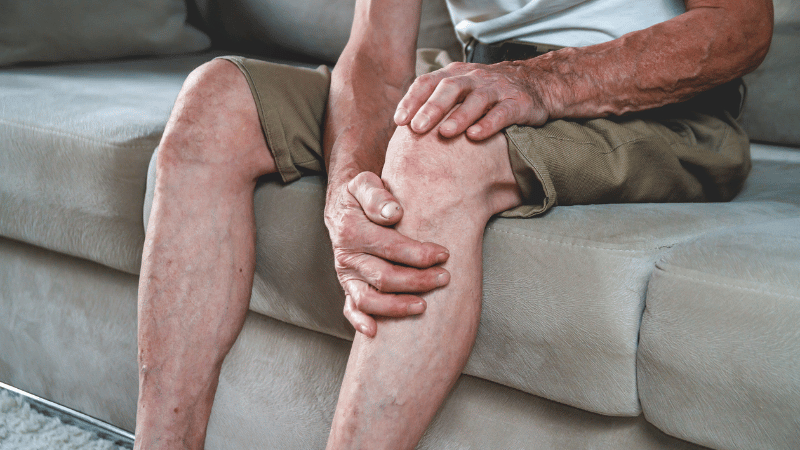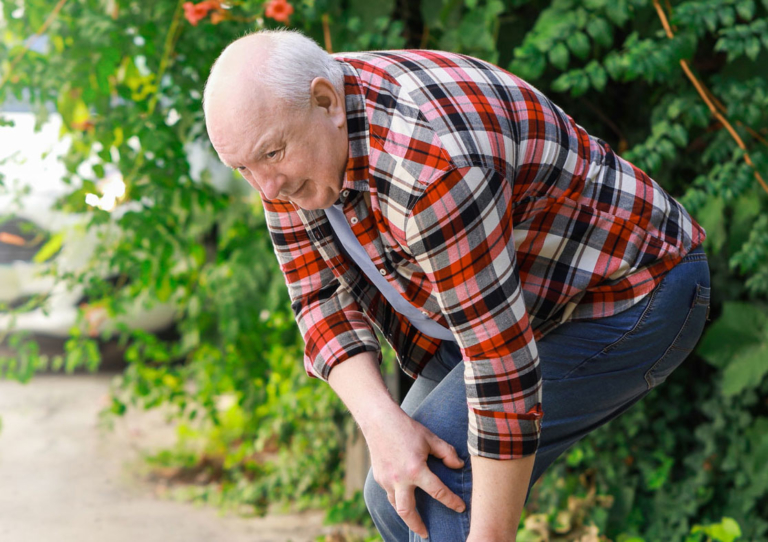Dealing with leg pain can be difficult because it greatly affects your mobility. Some people experience temporary leg pain as a result of a strained muscle or an intense workout session, while others deal with chronic pain due to underlying conditions, such as peripheral artery disease (PAD).
Leg pain can occur due to various reasons including cramps, injury or plaque buildup in your arteries. Understanding the symptoms and available treatments is important to recognize that there are several ways to relieve and manage leg pain effectively, depending on the underlying cause.
Learn more about ways to relieve leg pain and the warning signs that indicate the need for professional care if you think PAD is contributing to your symptoms.
Understanding the Causes of Leg Pain
Leg pain can be acute or chronic, with several potential causes. Understanding the causes can help you find the best pain management method.
Some of the most common causes include:
- Poor Circulation: Vascular conditions like peripheral artery disease (PAD) can reduce blood flow to the lower extremities, leading to numbness and weakness in the legs.
- Nerve Issues: Sciatica and neuropathy cause nerve compression, leading to vasoconstriction and reduced blood flow.
- Muscle Strain or Injuries: Muscle strains and overuse cause tears in the muscle fibers, leading to acute leg pain.
- Chronic Conditions: Diabetes, arthritis, varicose veins and PAD can impact circulation and blood flow, leading to chronic pain in the legs and feet.
Vascular Conditions That Cause Leg Pain
Leg pain is often linked to vascular health. Two common vascular conditions that cause chronic leg pain include:
Peripheral Artery Disease (PAD)
Peripheral artery disease is a vascular condition caused by plaque buildup in the arteries. Plaque buildup restricts blood flow, depriving the lower extremities of oxygen and nutrients, which can cause chronic pain and discomfort.
Common symptoms of PAD-related leg pain include:
- Numbness
- Tingling in the legs
- Shiny skin
- Pain or cramping after activity
- Rest pain
- Persistent sores or ulcers that won’t heal
Peripheral artery disease is a progressive disease that requires treatment. If the warning signs and symptoms are ignored, PAD can lead to severe complications, including critical limb ischemia and amputation. If you’re experiencing these symptoms, scheduling a proper diagnosis with a medical professional is important.
The specialists at USA Vascular Centers offer comprehensive vascular screenings to diagnose PAD and develop a personalized treatment plan. Schedule a consultation today to take the next step toward better vascular health.
Chronic Venous Insufficiency (CVI)
Chronic venous insufficiency (CVI) is a venous disease caused by damage to the veins in the legs. When the veins are damaged, they can’t properly pump blood back to the heart, causing blood to pool in the legs. This condition can cause pain, discomfort, and swelling. A physical examination is required for a proper diagnosis.
10 Ways to Relieve and Treat Leg Pain
There are several effective methods to relieve leg pain. These are categorized into short-term relief, long-term management, and the need for professional treatment.
Quick Pain Relief Methods
- Rest and Elevation: Elevating your legs can help restore blood flow and reduce swelling. It can also help relieve pressure and improve circulation. After prolonged standing, exercise, or before bed, keeping your legs elevated above heart level for a 15-20 minute session is beneficial to promote circulation and proper leg pain relief.
- Cold vs. Heat Therapy: Cold therapy can help reduce inflammation, swelling, and discomfort after a muscle strain or intense workout. You’ll want to follow up with heat therapy to help loosen tightened muscles in the area.
- Stretching & Movement: Daily stretches before a workout can help improve blood flow and flexibility. It can also keep you protected from muscle strains. You should hold a stretch for 20 seconds three consecutive times before moving on to the next one.
- Over-the-Counter Pain Relievers: NSAIDs can relieve short-term leg pain.
Long-Term Pain Management
- Exercise for Circulation & Muscle Strength: Swimming, cycling, or walking are low-impact workouts that can help improve circulation and muscle strength. Simple exercises like calf raises, leg raises, and leg extensions can also be beneficial for leg pain relief.
- Anti-Inflammatory Diet & Nutrition: Foods like avocados, olive oil, green tea, and berries can help reduce vascular inflammation, providing long-term benefits to your cardiovascular health.
- Weight Management to Reduce Strain on Legs: Maintaining a healthy weight can reduce inflammation and improve circulation. Excess weight increases strain on the cardiovascular system and joints, increasing the risk of stroke or a heart attack.
- Routine Checkups: Regular health screenings can help detect vascular conditions before they progress. Early detection can also help prevent symptoms from worsening and provide peace of mind.
Professional Treatment
- Wound Care for Ulcers: Non-healing wounds caused by poor circulation require specialized care and attention from a medical provider. If you suspect PAD is the cause, consult a vascular specialist to assess the severity and determine the best wound care approach.
- Vascular Treatments for PAD: If your leg pain is caused by PAD, a vascular specialist may recommend a minimally invasive treatment like angioplasty, stent placement, and atherectomy. These treatments can help make symptoms more manageable and improve your quality of life.
Peripheral Artery Disease Treatment at USA Vascular Centers
Treatment options for PAD include surgical and non-surgical procedures. Smoking cessation, eating a healthy diet, and exercising regularly can help control the symptoms of PAD. Some doctors recommend surgery, but a non-surgical PAD treatment option is always available to you as surgery can increase risk for injury and infection.
At USA Vascular Centers, we offer you a non-surgical option on how to stop leg pain with the help of balloon angioplasty. Unlike PAD surgery, you will be allowed to leave after your non-surgical PAD treatment. Our treatment has a fast recovery rate and you will be able to resume your daily activities within a week.
Take Charge of Leg Pain Relief Today
Persistent leg pain can indicate underlying issues that require a proper medical evaluation. By combining lifestyle changes with professional care, you can find relief and prevent future discomfort.
If PAD is contributing to your chronic leg pain, USA Vascular Centers is here to help. Our vascular doctors provide personalized treatment plans. After a thorough evaluation and diagnosis, we’ll discuss your options and determine the best approach for you.
Schedule a consultation with our experts today to take the next step toward relief.
FAQs About Leg Pain Relief
Can sleeping positions affect leg pain?
Yes, sleeping with your legs elevated can improve circulation and reduce swelling in the legs, while sleeping in a tight fetal position may restrict blood flow and cause additional discomfort.
Does sitting too much cause leg pain?
Yes, prolonged sitting can reduce circulation, leading to stiffness, swelling, and cramping in the legs. Moving your legs every 30–60 minutes can help prevent pain and improve circulation in the lower extremities.
What’s the difference between acute and chronic leg pain?
Acute pain is a short-term, sudden and sharp pain. In contrast, chronic pain is persistent and long-term.




